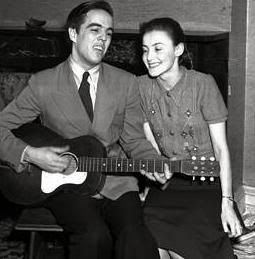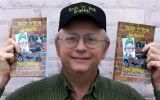
By STEVE SEYMOUR
Many people are surprised to learn the Upper Peninsula has a musical heritage as unique and sought-after as the culturally important blues and jazz music of the American south in the middle of the last century.
This little-known chapter in U. P. history actually starts with folklorist and musicologist John Lomax and his son Alan. In the late 1920s, the Library of Congress had identified a need to preserve fading American culture by collecting ethnic folk songs. In 1933, the elder Lomax was appointed honorary curator of the newly established Archive of American Folk Song.
The pair initially traveled through Texas, Louisiana and Mississippi recording the traditional fieldwork songs of black prisoners, eventually running across a treasure in the person of Huddie "Leadbelly" Ledbetter, an original bluesman, composer and extraordinary musical resource. With help from the Lomaxes, Leadbelly was released from prison, moved to New York City and became the most popular blues performer among white audiences.
By 1936, Alan became the Archive's first federally-paid staff member and was named "assistant in charge" the following year.
While the younger Lomax made many field recording trips to the southern states to record such notables as Jelly Roll Morton and Muddy Waters, the Texan also made a significant northern sojourn in 1938 which included the Upper Peninsula.
Lomax collected about 1,000 songs from August to November that year, most of them from the U. P., during what was called a "reconnaissance survey." 
In an annual report Lomax said, "The Upper Peninsula proved to be the most fertile source of material. After six weeks of recording a mass of lumberjack, Finnish and French folk-songs, I felt that there was material enough in the region for years of work. Near Newberry, Munising, Greenland and Ontonagon, it was comparatively easy to find lumberjack singers. Everywhere through the Copper Country and south of it, Finnish singers generously furnished me with more material than I had time to record. In Champion and Baraga, I found French ballad singers who still enjoyed ballad fests that lasted all night long."
His time on Beaver Island, Aug. 24-29, was especially fruitful. Lomax was proud of recording two "remarkable" ballad singers, Dominick Gallagher and Johnny Green. Green performed over 100 Irish ballads for Lomax and later wrote that he had recalled 150 more.
Recordings were also made in St. Ignace, Champion, Marinesco, Amasa, Calumet, Fulton, Charles, Round Lake, Hancock, Allouez, Laurium and Ironwood.
Escanaba is notably absent from that list, although it is known Lomax stopped here, arriving from Munising. His visit is not mentioned in the Escanaba Daily Press, but federal government mileage reimbursement records indicate Lomax spent Sept. 19-21, 1938, in the city. Escanaba isn't represented by any field recordings, either. Is it possible Lomax did not record in our fair city?
To get to the bottom of this mystery, I contacted Nathan Salsburg, production manager and catalog editor for the Alan Lomax Archive & The Association for Cultural Equity in New York City. "I understand that it seems suspect that he would spend two days there and not have recorded, but the best record is the "List of Recordings in the Archive of Folk Song," published by the Library in 1940, and that does not include anything from Escanaba."
"In fact," Salsburg said, "Lomax often chose not to make recordings in larger urban areas, as the influence that popular culture had on traditional material in such places didn't serve his purposes."
Perhaps Escanaba was too cosmopolitan for Lomax. Afterall, Time Magazine had recently featured a story on the town's annual smelt jamboree, in which "20,000 curious tourists were welcomed with open arms by the 15,000 natives." Residents also pointed to the progress wrought by the newly built automated light at the entrance to the harbor, a quarter mile off-shore from Sand Point Lighthouse.
Despite that, the 23-year-old Lomax apparently left town without turning on his recording equipment.
He spent the period through mid-October recording Finnish musicians in the western U. P., returning to Washington, D. C. in late 1938.
Lomax left the Library of Congress in 1942 but continued as a folklorist and musicologist, collecting thousands of songs in the United States, Great Britian, Caribbean, Scotland, Ireland, Italy and Spain over the course of his career. Before his death in 2002, Lomax amassed one of the world's most important collections of ethnographic material including sound recordings, film, manuscripts and photographs.
We can take pride knowing some of the voices of the Upper Peninsula's rich musical past will live on in such a prominent collection, and that Lomax thought they were important enough to gather in the first place.


 I've enjoyed rock music and writing since I was a teenager in the 60s. I feel lucky to have been around when rock's greatest stars created their most enduring hits. At the same time I found I enjoyed writing, as well. I worked on my high school newspaper and magazine, was editor of several college publications and earned a bachelor's degree from Central Michigan University in 1973. I worked for the daily newspaper in my hometown after graduating, becoming managing editor after a few years. By the 1980s, I moved into public relations. In 1985, my wife Sue and I opened a retail music store, The Record Rack, which we still own. Rock 'n' roll has been integral to me and for the last 2O years I've been earning my living from it even though I don't have a musical bone in my body. In recent years, I've also I edited a small local magazine and launched a micro FM radio station. Now, I'm finally combining my love of writing and rock 'n' roll. I can't sing a note, but I know what I like. I'll tell you all about it when you read on. I hope you have as much enjoyment reading these installments as I've had writing them.
I've enjoyed rock music and writing since I was a teenager in the 60s. I feel lucky to have been around when rock's greatest stars created their most enduring hits. At the same time I found I enjoyed writing, as well. I worked on my high school newspaper and magazine, was editor of several college publications and earned a bachelor's degree from Central Michigan University in 1973. I worked for the daily newspaper in my hometown after graduating, becoming managing editor after a few years. By the 1980s, I moved into public relations. In 1985, my wife Sue and I opened a retail music store, The Record Rack, which we still own. Rock 'n' roll has been integral to me and for the last 2O years I've been earning my living from it even though I don't have a musical bone in my body. In recent years, I've also I edited a small local magazine and launched a micro FM radio station. Now, I'm finally combining my love of writing and rock 'n' roll. I can't sing a note, but I know what I like. I'll tell you all about it when you read on. I hope you have as much enjoyment reading these installments as I've had writing them.


No comments:
Post a Comment